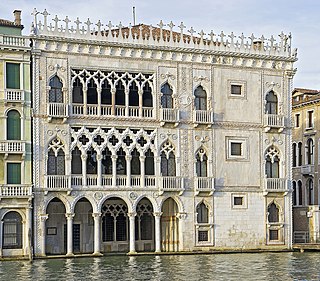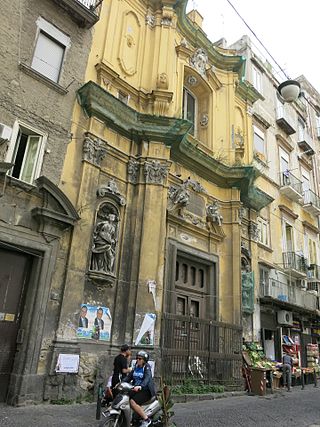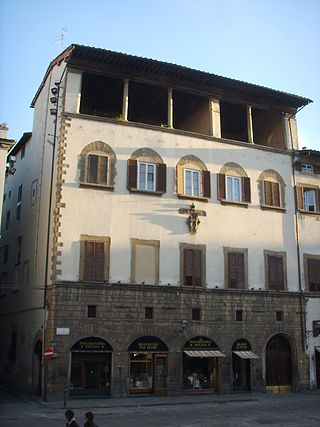
The Doge's Palace is a palace built in Venetian Gothic style, and one of the main landmarks of the city of Venice in northern Italy. The palace was the residence of the Doge of Venice, the supreme authority of the former Republic of Venice. It was built in 1340 and extended and modified in the following centuries. It became a museum in 1923 and is one of the 11 museums run by the Fondazione Musei Civici di Venezia.

The Grand Canal is a channel in Venice, Italy. It forms one of the major water-traffic corridors in the city.

The Ca' d'Oro or Palazzo Santa Sofia is a palace on the Grand Canal in Venice, northern Italy. One of the older palaces in the city, its name means "golden house" due to the gilt and polychrome external decorations which once adorned its walls. Since 1927, it has been used as a museum, as the Galleria Giorgio Franchetti.

Ca' Foscari, the palace of the Foscari family, is a Gothic building on the waterfront of the Grand Canal in the Dorsoduro sestiere of Venice, Italy.

Castel Nuovo, often called Maschio Angioino, is a medieval castle located in front of Piazza Municipio and the city hall in central Naples, Campania, Italy. Its scenic location and imposing size makes the castle, first erected in 1279, one of the main architectural landmarks of the city. It was a royal seat for kings of Naples, Aragon and Spain until 1815.

Santa Maria della Colonna is a Baroque style deconsecrated Roman Catholic church in central Naples, region of Campania, Italy. It stands across from the church of the Girolamini.
Santa Maria Assunta dei Pignatelli is a deconsecrated Roman Catholic church located at the end of Via Nilo in Naples, region of Campania, Italy. In the small piazza in front of the church is an ancient Roman statue of the Nile God.

The Fountain of Neptune is a monumental fountain, located in Municipio square, in Naples, Italy. The fountain until the end of 2014 was located across the street of via Medina across from the church of Santa Maria Incoronata, Naples and a few doors south of the church complex of Pieta di Turchini. Now the fountain is located in front of the Town hill building, its location changed due to the construction of the new underground station.

Santa Maria della Quercia is a Roman Catholic church located on the piazza of the same name, one block southeast of the Palazzo Farnese in the Rione (district) of Regola of central Rome, Italy.

Santo Spirito dei Napoletani is a Roman Catholic church on via Giulia, in the Regola rione of Rome. It was the national church of the Kingdom of the Two Sicilies and is now the regional church for Campania.

Santi Simone e Giuda is a deconsecrated Catholic church in the center of Rome, Italy. It is important for historical reasons.
The Santissimo Salvatore Church is a church in Naples, located in the historical centre of the Piscinola suburb.

Pietro de Marino was an Italian architect born in Naples and active there between 1629 and 1666. His works include the former church of San Potito.

Palazzo di Sangro, also known as either Palazzo de Sangro di Sansevero or Palazzo Sansevero, is a late-Renaissance-style aristocratic palace facing the church of San Domenico Maggiore, separated by the via named after the church, in the city center of Naples, Italy. Part of the palace facade faces the piazza in front of the church, which is also bordered to the south by the Palazzo di Sangro di Casacalenda.

The Palazzo di Sangro di Casacalenda is an 18th-century aristocratic palace located across a pizza from the church of San Domenico Maggiore in central Naples, region of Campania, Italy. The East flank of the facade faces the facade of the church of Sant'Angelo a Nilo.

Palazzo Corner Contarini dei Cavalli is a palace in Venice, located in the San Marco district, overlooking the left side of the Grand Canal, between the Rio di San Luca and Palazzo Grimani di San Luca on one side and Palazzo Tron and Palazzetto Tron Memmo on the other. The opposite structure is the Palazzo Papadopoli.

Palazzo Cavalli or Palazzo Corner Martinengo is a palace in Venice, located in the San Marco district and overlooking the Grand Canal. It locates not far from the Ponte di Rialto, between Palazzo Corner Valmarana and Ca' Farsetti, in front of Palazzo Barzizza.

Palazzo Gradenigo is a palace in Venice, located in the Santa Croce district, near Palazzo Soranzo Cappello and the church of San Simeone Profeta, and overlooking Rio Marin.

Palazzo Della Stufa or Lotteringhi Della Stufa, is in the Piazza San Lorenzo, at the corner of Via della Stufa, in Florence, Italy, in front of the Basilica di San Lorenzo.



















